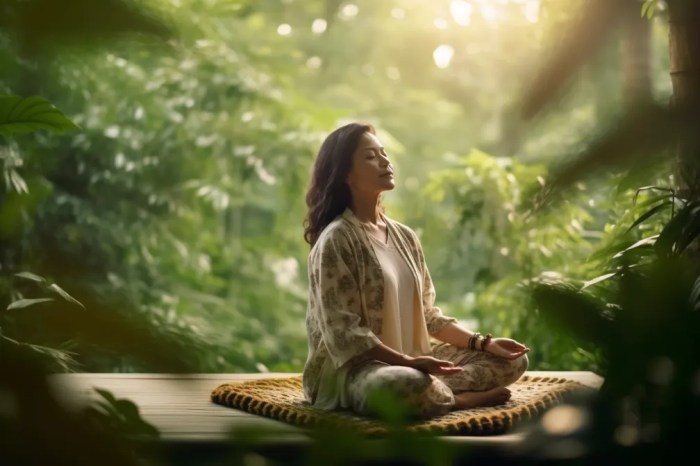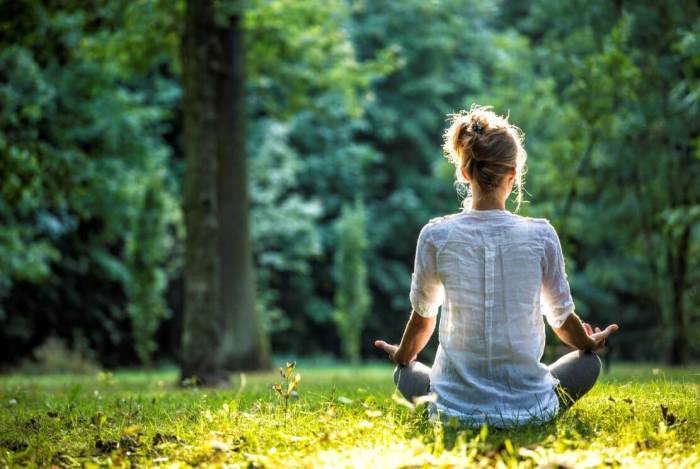Kicking off with 6 Techniques to Create a Peaceful Meditation Environment, this guide dives into practical tips for setting up a serene and calming space for your meditation practice. From decluttering to personalizing your space, discover how to enhance your meditation experience with these techniques.
Setting the Physical Space

Creating an ideal location for a peaceful meditation environment is crucial for enhancing your practice and promoting a sense of calm and tranquility. Here are some key elements to consider:
Ideal Location
When setting up your meditation space, choose a quiet and clutter-free area in your home where you can have privacy and peace. Ideally, this space should be away from distractions and noise to help you focus and relax.
Essential Items
- Comfortable cushions or a meditation mat to sit on
- A cozy blanket for warmth
- A small table or shelf to hold any meditation aids or decor
- A soothing essential oil diffuser or scented candles for relaxation
- Inspirational quotes or imagery for motivation and positivity
Lighting
Lighting plays a crucial role in creating the right ambiance for meditation. Soft, natural light is ideal for a calming atmosphere. Consider using candles, fairy lights, or dimmable lamps to adjust the brightness according to your preference.
Natural Elements
Incorporating natural elements like plants or water features can further enhance the serenity of your meditation space. Plants not only add a touch of greenery but also help purify the air and create a sense of connection to nature. A small tabletop fountain or a bowl of water can create a soothing sound that aids in relaxation.
Decluttering and Organizing

Decluttering the meditation space is essential to create a peaceful environment free of distractions. When the space is cluttered, it can be challenging to focus and relax during meditation. Organizing meditation tools and accessories in a systematic way can also help enhance the overall experience.
The Importance of Decluttering
- Remove unnecessary items from the meditation area to create a sense of calmness.
- Clearing clutter can promote mental clarity and reduce feelings of overwhelm.
- A tidy space can help you feel more at ease and focused during meditation.
Techniques for Organizing Meditation Tools
- Use storage baskets or bins to keep essential items neatly organized and easily accessible.
- Label containers to quickly identify different tools and accessories.
- Designate specific areas for each item to maintain order and cleanliness.
Minimalism for a Peaceful Environment
- Embrace minimalism by keeping only what is truly necessary for your meditation practice.
- Reducing clutter can create a sense of spaciousness and tranquility in the meditation space.
- Minimalist decor and furnishings can contribute to a calming and harmonious environment.
Storage Solutions for a Tidy Meditation Area
- Utilize shelves or bookcases to store meditation cushions, blankets, and other accessories.
- Invest in a storage ottoman or bench to keep items out of sight but easily accessible.
- Consider using a decorative cabinet or armoire to store meditation tools while adding aesthetic appeal to the space.
Choosing Calming Colors and Decor
Creating a serene meditation environment involves carefully selecting colors and decor elements that promote relaxation and peace of mind.
Significance of Color Psychology
Color psychology plays a crucial role in setting the mood and ambiance of a space. Certain colors have the ability to evoke feelings of calmness, tranquility, and balance, making them ideal choices for a meditation area.
Soothing Color Schemes
- Soft blues and greens: These colors are often associated with nature and serenity, helping to create a sense of harmony and tranquility.
- Earth tones: Shades of brown, beige, and taupe can bring warmth and grounding to the space, fostering a connection to the earth.
- Lavender and lilac: These gentle hues are known for their calming and soothing properties, perfect for promoting relaxation during meditation.
Calming Decor Elements
To enhance the peaceful atmosphere, consider incorporating soft and inviting decor elements such as:
- Cushions and pillows: Opt for plush cushions in calming colors to provide comfort and support during meditation sessions.
- Rugs and mats: Choose soft, textured rugs or mats to create a cozy and inviting space for meditation practice.
- Curtains or drapes: Light, sheer curtains can help diffuse natural light and create a soft, tranquil ambiance in the room.
Harmonious Color Palette
When selecting colors for your meditation space, aim for a harmonious color palette that promotes relaxation and mindfulness. Consider choosing colors that complement each other and create a sense of balance and unity within the room.
Incorporating Aromatherapy and Soundscapes

Creating a sensory-rich environment in your meditation space can greatly enhance your practice and promote relaxation. Incorporating aromatherapy with essential oils and soothing soundscapes can help you achieve a deeper state of peace and mindfulness.
Benefits of Aromatherapy in a Meditation Setting
Aromatherapy involves using natural plant extracts to promote health and well-being. In a meditation setting, the benefits of aromatherapy include:
- Calming the mind and reducing stress
- Enhancing focus and concentration
- Promoting relaxation and a sense of tranquility
Popular Essential Oils and Scents for Relaxation
When choosing essential oils for your meditation space, consider scents that promote relaxation and calmness. Some popular essential oils for meditation include:
- Lavender: known for its calming and soothing properties
- Sandalwood: helps to quiet the mind and promote mental clarity
- Frankincense: aids in deepening meditation and spiritual connection
Role of Soundscapes in Enhancing the Meditation Experience
Soundscapes or background music can create a peaceful atmosphere and enhance the meditation experience. The role of sound in meditation includes:
- Masking distracting noises and promoting focus
- Setting a calming tone and creating a sense of tranquility
- Enhancing relaxation and deepening the meditative state
Creating a Sensory-Rich Environment through Scents and Sounds
To create a sensory-rich environment for meditation, combine aromatherapy with soothing soundscapes. Choose essential oils that complement the calming music you play in the background. Experiment with different scents and sounds to find the perfect combination that helps you relax and center your mind during meditation.
Establishing a Comfortable Seating Arrangement
When creating a peaceful meditation environment, the seating arrangement plays a crucial role in enhancing comfort and focus during meditation sessions. A comfortable seating arrangement not only helps maintain good posture but also contributes to a sense of relaxation and tranquility.
Seating Options
- Cushions: Cushions provide a soft and supportive base for sitting cross-legged or in a kneeling position. They help in elevating the hips above the knees, promoting proper spinal alignment.
- Mats: Mats offer a firm and stable surface for meditation. They can be used on the floor or a chair to provide a comfortable seating option.
- Chairs: Chairs with proper back support can be a great choice for those who prefer a more traditional seating arrangement. They help in maintaining a straight back and relaxed posture.
Ergonomics and Posture
Ergonomics play a vital role in ensuring that the seating arrangement supports good posture during meditation. It is essential to choose a seat that aligns the spine properly, supports the natural curves of the back, and keeps the body relaxed yet alert.
Choosing the Right Seating Arrangement, 6 Techniques to Create a Peaceful Meditation Environment
When selecting a seating arrangement for meditation, consider your individual preferences and comfort. Experiment with different options to find what works best for you. Remember, the goal is to create a space that allows you to relax, focus, and connect with your inner self.
Personalizing the Meditation Space: 6 Techniques To Create A Peaceful Meditation Environment

Creating a personalized meditation space is essential to make the environment truly yours and enhance your meditation experience. By infusing your unique preferences and personal items, you can transform the space into a sanctuary that resonates with your soul.
Significance of Personal Items
- Personal items like photographs, crystals, or spiritual symbols can evoke positive emotions and memories, creating a comforting atmosphere.
- Incorporating items that hold personal significance can deepen your connection to the space and help you feel more grounded during meditation.
- By surrounding yourself with objects that bring you joy and peace, you can enhance your overall sense of well-being and relaxation.
Creating a Sacred Space
- Designating a specific area solely for meditation can help establish a sense of sacredness and ritual in your practice.
- You can personalize this space with items that inspire reverence and tranquility, such as candles, incense, or meaningful artwork.
- Having a dedicated sacred space can signal to your mind that it’s time for meditation, making it easier to transition into a mindful state.
Infusing Personal Touches
- Consider incorporating elements that reflect your personality or spiritual beliefs, such as a favorite quote, mantra, or prayer.
- You can personalize the space further by adding cushions, blankets, or meditation tools that cater to your comfort and preferences.
- Avoid cluttering the environment by selecting a few meaningful items that resonate with you and contribute to a peaceful ambiance.
Concluding Remarks

In conclusion, incorporating these techniques can transform your meditation area into a peaceful sanctuary where you can relax and rejuvenate your mind, body, and soul. By following these tips, you can create a harmonious environment that promotes deep meditation and mindfulness.